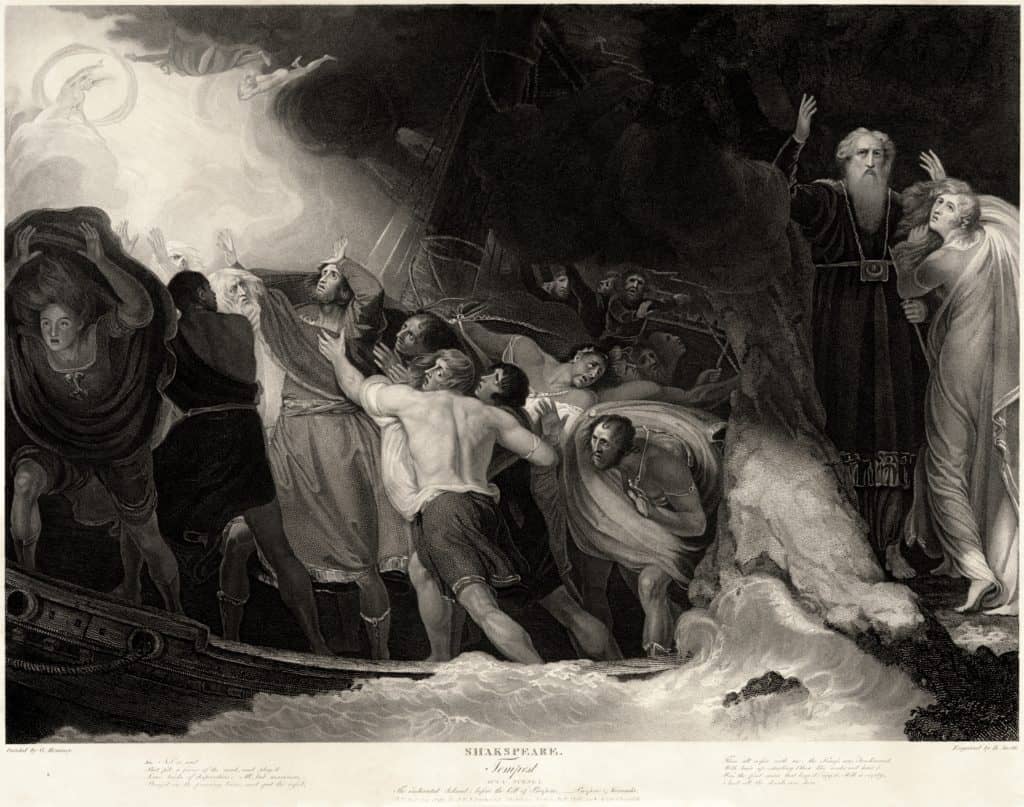The Odyssey is the oldest seafaring story of which there is a written record, an oral account set to papyrus some eight centuries before Christ. The Wreck of the Edmund Fitzgerald is the only shipwreck song to make it to No. 2 on the Billboard charts, reaching No.1 in 1977 in singer Gordon Lightfoot’s native Canada.
In literature, Moby-Dick is surely the most famous allegorical sea story of all-time save for the Biblical Jonah, or, if you prefer, Noah. In the final pages of his masterpiece, when the white whale triumphed over Ahab’s hubris, Melville wrote: “The ship! Great God, where is the ship? And the great shroud of the sea rolled on as it rolled five thousand years ago.”
As it rolls today off the coast of Maryland, some 140 miles east of Ellicott City, where the Chesapeake Shakespeare Company has staged The Tempest, the last play completed by Shakespeare before his death in 1616. The curtain rises on a shipwreck, one portrayed onstage more than any other in history.
A small ship, returning from Tunisia to Naples with double-crossing Napolitano royalty on board, encounters a gale on the Tyrrhenian Sea. The storm proves to be merciless and the King of Naples and his family discover, not unlike the aristocrats aboard the Titanic, that their wealth holds no status with the fury of the sea.
The Boatswain shouts at the courtiers, who are a nuisance as the crew tries to save the vessel: “What care these roarers for the name of king?”
And the sailors cried: “Mercy on us! We split, we split!”
How to portray a wooden boat headed for Davy Jones’ Locker upon the dry boards of the theater?
The answer is one of those moments where kids can try this at home if they decide to put on a show. Root through the family laundry for a few blue bath towels. And mind Baltimore set designer Dan O’Brien, a one-time tugboat man from St. Louis in the employ of the Chesapeake Shakespeare Company. O’Brien, 43, created the set for the troupe’s 2017 production of The Tempest at an outdoor theater in Ellicott City.
“Our main set was a beach on the island with rocks and caves, just before Prospero conjures the storm,” said O’Brien, referencing the former Duke of Milan, now a sorcerer in exile on a magical island with his daughter Miranda. “On the ‘beach’ there were mute spirits waving blue fabric for the waves.”
The true collaboration in theater, said O’Brien, is always with the audience, and the secret ingredient is the spectators’ imagination and their willingness to indulge. Much of the exposition is contained in dialogue. Yet the ship must go down for the story to proceed.
The ship is a small vessel said to be modeled (though in dispute, this being the Bard) on the wreck of the Sea Venture off Bermuda in 1609. According to the Royal Shakespeare Theater of Stratford-upon-Avon, however, a ship called the Prince Royal was launched on the Thames in the fall of 1610. Named for the Prince of Wales—Henry, son of James I—it also encountered a mighty squall.
The shipbuilder, with the Dickensian name of Phineas Pett, wrote in a journal his suspicions that enemies had summoned the storm to thwart him—all in keeping with the role Shakespeare wrote for Prospero in The Tempest.
The Chesapeake Shakespeare Company last performed The Tempest at the ruins of a Civil War-era school for girls in Ellicott City called the Patapsco Female Institute, open on several sides and a popular spot for weddings. It was a daylight performance and thus could have no theatrical sleight-of-hand with lighting.
The ship was portrayed by a toy cut in half and held aloft on sticks—one for the front, the other behind it. “For the sinking,” said O’Brien, the actors holding the sticks, “split the boat in two. While all this is going on, you have sailors and the captain … acting out lines being said on the ship in the midst of the storm.”
Nathan Thomas was the Prospero who conjured that storm. “The opening storm scene was always a journey for me. I always imagined that it had been an otherwise calm day,” said Thomas. “Once Prospero realizes who was on the ship [those who had banished him and daughter Miranda to the seas in a small boat], he realizes that his chance for justice was here.
And thus, said Thomas, the rightful Duke “worked swiftly to [call forth] the storm to get the gears of the plot going.”
Two of the abiding themes of the story are forgiveness and control. As someone with power over the elements, Prospero might have sent them all to their deaths—just as they surely had no qualms about doing the same to him and the teenage Miranda.
“It’s a question of getting the winds started but then keeping them from getting out of hand,” said Thomas. “Prospero wanted control over the elements, his enemies, his surroundings—everything.”
It sounds very Ahab-esque, except that the master of the Pequod never practiced restraint, confirmed most famously by his declaration, “Talk not to me of blasphemy, man; I would strike the sun if it insulted me.”
To O’Brien, what lingers after the final curtain has come down is the virtue of forgiveness. Prospero is a man not only sane enough to leave the sun to its rise-and-fall but strong enough to resist revenge in the end. Thus, The Tempest (which ends in Miranda’s marriage) is an Elizabethan comedy and not a tragedy.
As for raging waves represented by bolts of blue cloth and tiny ships on sticks, be alert to the final act where Miranda says, “I would call it fair play.”
And thus, fair enough. As Charlie Stein, a long-ago Prospero at Loyola College in 1980 with the Evergreen Players, said, “You can do anything you damn well please with Shakespeare. But you’ve got to do it right.”



